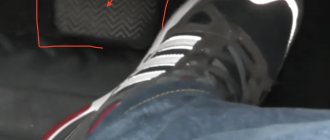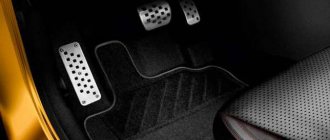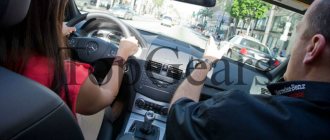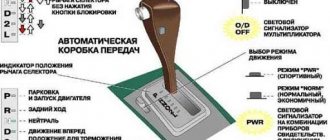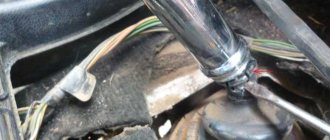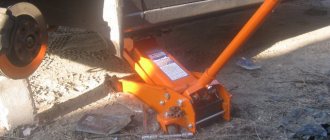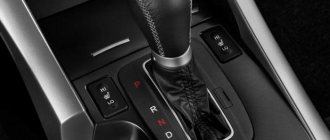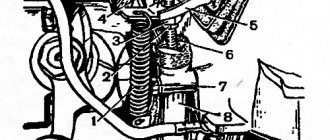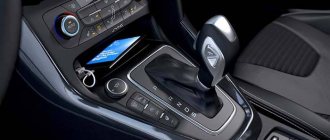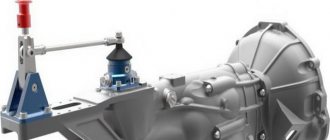In terms of its design features, a robotic gearbox is a manual transmission, with the exception that gear shifts and clutch operation are carried out using an ECU and servomechanisms.
This box has both its pros and cons. The main advantage is fuel efficiency, as well as the relative ease of production of single-disc AMT type robots. As for preselective robotic gearboxes (DSG and analogues), their main advantage is the double clutch, due to which gear changes occur very quickly and unnoticed by the driver.
The disadvantages of both types of robotic gearboxes are very rapid wear of clutch packs, individual actuators, contamination of sensors, souring of contacts, problems with mechatronics, solenoids, etc.
At the same time, repairing and servicing the robot box will not cost the car owner cheap. For this reason, it is necessary to maintain the manual transmission on time and operate the unit correctly. Next, we will look at the features of operation and maintenance of the robot box, and also answer the question of whether the robot box can be towed.
Traffic rules requirements
The issue of towing another car with an automatic transmission, as with towing using a manual transmission, is regulated by current legislation. In accordance with the traffic rules, towing is possible only if a number of certain requirements are met, which can be refreshed by studying section “20” of the traffic rules.
In accordance with traffic regulations:
1. A driver must be present at the wheel of a car that is being towed, except in cases where towing is carried out using a rigid coupling and in a straight line.
2. If you happen to be, which is of course unlikely, towing a bus, trolleybus or truck, then you cannot transport passengers in its cabin - they should move to you.
3. The distance between the towed and the towing should be clearly ensured - 4-6 meters when moving on a flexible hitch and less than 4 on a rigid one. Also, the flexible coupling must have a special color marking.
4. It is prohibited to tow vehicles that do not have steering or braking systems, as well as two or more vehicles. Moreover, a car with a non-working steering wheel and brakes is still allowed to be towed using the partial loading method, but if you own a passenger car or a jeep, then you most likely will not have to resort to this method of transportation.
5. Drivers of two-wheeled motorcycles without trailers are also not allowed to tow.
The list of requirements is exhaustive, and violation entails administrative liability and a fine.
To avoid ending up in an unpleasant situation, we recommend that you always carry a copy of the current traffic regulations in your glove compartment so that you can make sure that when providing roadside assistance, you are not breaking the letter of the law.
In any case, we believe that if you have the opportunity to provide roadside assistance without damaging your car or breaking the law, you should definitely do so. If you refuse, then perhaps at the moment when you yourself need the support of passing cars, no one will stop.
In what cases is towing a car prohibited?
Without touching on the technical limitations that have already been mentioned, we can recall the existence of the Traffic Rules and traffic police officers.
- The driver of the first car must have at least two years of experience;
- Cars remain participants in the movement, so all requirements for documents, signs and lighting remain the same;
- Driving with a trailer should not be prohibited on this section of the road;
- You cannot tow motorcycles, especially mopeds and bicycles, like them;
- You can only tow one vehicle and no trailers;
- You cannot tow with a flexible hitch in icy conditions;
- The steering and brakes must be in good working order, otherwise only partial loading is allowed in the first case and a rigid coupling in the second.
In any case, you shouldn’t immediately drive into busy areas, but check if everything is fine, it’s better if there are no obstacles, only then increase the speed and hit the road.
If this happened
So, you were driving along the highway, and your car stopped for unknown reasons, you can’t start it, and you can’t call a tow truck. By the way, let us immediately note that you should resort to driving a car equipped with an automatic transmission with the help of a tow only as a last resort.
Towing a car is always a risk of damaging gearbox components; try to avoid this method of transportation. But if there is no choice left, then you should know how to properly tow a car if it has an automatic transmission on board.
7 simple rules from our portal that must be followed to maintain the functionality of your automatic transmission:
1.Before towing your car, be sure to use transmission fluid for the automatic transmission, which will allow you to raise the oil level in the box, minimizing the damage from driving with the engine off.
2. Towing a vehicle equipped with an automatic transmission is only possible with the gear shift knob in the “N” (neutral) position.
3.If there is a three-speed gearbox, the towing speed cannot exceed 30 kilometers/hour for no further than 30 km.
4. If you have an automatic transmission with 4 stages or more, you can drive 50 km in tow at a speed of 50 km/h.
5. Load the car as much as possible when towing if the brakes have failed. If necessary, transfer passengers and load luggage from the car that is towing you
6.Cooling by additional methods will definitely be required if you have a trailer, since the load on the gearbox components will increase. Stop often to let the parts cool down.
7.Smoothness and uniformity of movement is the last key to the success of your venture. Take your time - driving fast in such a situation is definitely not recommended.
Types of automatic transmission
Car owners traditionally call the entire transmission of a car a gearbox. From a technical point of view, the gearbox is considered to be only that part of the unit in which a number of planetary gears are located that ensure gear shifting.
An automatic transmission can be considered any device that changes gears without driver intervention, but traditionally the name “automatic transmission” has been assigned to a hydromechanical design. Conventionally, automatic transmissions also include a variator and a robotic gearbox.
Traditional automatic transmission
A traditional automatic transmission includes: a torque converter, a manual gearbox and a control system. And it is, in fact, a hydromechanical transmission. The torque converter in the automatic transmission acts as a clutch, i.e. it provides smooth supply and adjustment of torque from the engine to the gearbox. All its parts are enclosed in a housing in which they are in a special oil fluid - ATF.
When the engine starts, the crankshaft begins to rotate, and the movement of the torque converter pump wheel starts. It moves the ATF working fluid to the turbine wheel, which begins to rotate and transmits torque to the planetary gearboxes. The torque converter develops maximum torque at minimum speed.
As the speed increases further, the rotation of the pump and turbine wheels are aligned, the torque converter is locked, and torque is transferred directly from the engine to the manual transmission. Thus, when you press the gas pedal and increase the speed and vice versa, the gears are switched automatically.
Type-tronic
The type-tronic design is a type of automatic transmission that has a manual control mode. The driver can select gears manually while driving by moving the lever in the "+" and "-" directions. The structure of such a box is not fundamentally different from the traditional one; only the automatic control and gear shift lever are changed.
Driving a car with a type-tronic gearbox can be performed in two modes: full automatic and manual control. Manual mode imitates the control of a manual transmission in a sports car, but does not require the same serious skills and qualifications from the driver as from professional athletes in auto racing mode.
Robotic box
This transmission can be conditionally classified as automatic, since, in fact, it is a manual gearbox, but with electronic control. Gear shifting and clutch engagement are controlled automatically. The driver and driving conditions provide the input of information, and the operation of the box itself is started by an electronic unit, which contains a specific control algorithm.
The electronic control system includes sensors that receive information about rotation speed, selector lever position, oil level and pressure. They transmit information to the control unit, which analyzes them and selects the appropriate operating algorithm.
The robotic box can operate in two modes: full automatic and semi-automatic. Semi-automatic mode allows the driver to manually select the mode using a lever. This function is similar to the type-tronic in an automatic transmission. In some sources, the robotic gearbox is called a sequential gearbox.
Variable speed drive
The CVT transmission has the generally accepted abbreviation CVT, which in its full form means “continuously variable transmission”. The variator does not have fixed gears and switching between them. During operation, the variator constantly smoothly changes the gear ratio as the vehicle speed changes, so this design very conventionally applies to gearboxes.
The design of a CVT transmission consists of two pulleys and a V-belt stretched between them. The pulleys consist of two cones, the narrow part facing each other. The change in gear ratio occurs due to the smooth sliding of the belt along a smaller or larger radius of the pulley, so when moving, the torque changes continuously and there are no jerks.
The CVT provides comfortable driving, maximum efficiency in using engine power and fuel economy. However, due to the high complexity of the design, repairing the CVT box is very expensive.
Features of driving with a robotic gearbox
Since the robot is a compromise design, some features of driving a car should be taken into account. For example, a robotic unit does not always switch speeds correctly, which leads to a drop in acceleration intensity. When you press the gas pedal sharply, the gears shift downward with a delay. This feature should be taken into account when overtaking on the highway, especially when driving into oncoming traffic.
Is warm-up required?
The robotic gearbox does not require oil heating. After starting the engine, it is recommended to stand for 20-60 seconds until the gears scatter the lubricant over the friction surfaces. It is necessary to warm up the car in winter for several minutes until the engine speed stabilizes. Then you can use the car. The selector is moved to position A.
When the engine warms up, it is not necessary to set the gearbox selector to various positions, by analogy with hydromechanical units. After starting to move, it is recommended to drive 1-2 km at a reduced speed to reduce the load on the rubbing surfaces. Since the gearbox housing is located at a distance from the power unit, the oil in the transmission heats up after 10-15 km of travel.
Starting the upward movement and overcoming the descent
To start moving uphill in a car with a robot gearbox, you need to move the lever to position A, while simultaneously holding the car with the parking brake system. The driver then releases the brake lever and increases engine speed.
To reduce the rollback of the car, the driver needs to catch the moment the clutch is engaged and at the same time release the handbrake lever. Before starting to operate the car, it is recommended to perform several test attempts to start on a hill in order to understand the moment when the clutch begins to operate. In winter, the box switches to manual gear selection mode, which reduces slippage at the beginning of movement. After acceleration, the speeds are switched forcibly or the selector is moved to the automatic position.
As the speed increases, the transmission will increase gears, but if the engine speed drops, the transmission will switch to a lower speed in automatic mode. When driving downhill, the lever remains in position A, the gas pedal is released to apply engine braking.
To further reduce the speed, press the brake pedal. There is no need to shift the transmission selector to neutral.
Stopping and parking
A car with a robotic unit stops using standard brakes. The driver then sets the gearbox lever to neutral and engages the parking brake. The brake pedal is released, the driver can turn off the engine and remove the key from the lock. When stopping, for example at traffic lights, it is permissible to leave the selector in the forward position. When parked for a long time, it is necessary to move the lever to the neutral position, since the clutch wears out in the depressed position.
Other modes
Robotic gearboxes support additional operating modes:
- The mode, indicated by a snowflake icon, is intended for movement in winter. The box controller ensures starting from second gear and changes the gear shift algorithm, reducing wheel slip on slippery road surfaces.
- The “sport” function allows you to change gears at higher engine speeds, which ensures dynamic acceleration.
- Manual mode, which allows you to forcefully control the gearbox.
What is the difference between manual transmission and automatic transmission when towing?
When transporting a manual transmission using the towed method, one gear rotates. Moreover, even a switched off engine does not stop the lubrication process.
Towing a car with an automatic transmission is different in that the automatic transmission, when neutral gear is engaged, continues to operate at full power, that is, the entire mechanism is in motion. In this case, the machine inevitably overheats, which ultimately results in a reduction in its service life. The situation is further aggravated by the fact that the oil pump serving the gearbox is correlated with the operation of the internal combustion engine.
Accordingly, towing a vehicle with a switched off internal combustion engine contributes to a catastrophic increase in the risk of machine breakdown, since it will not be provided with oil.
Is it possible to tow a robotic box?
Due to its design features, towing a manual transmission is not recommended, since such a gearbox may fail. Moreover, if for one technical reason or another the car cannot continue moving on its own (for example, towing a DSG is still inevitable), certain rules must be followed during this procedure.
First of all, you should first clarify the information in the repair and operation manual for a particular vehicle. In other words, you need to determine from the manual whether it is possible to tow a particular manual transmission without hanging the drive wheels.
If there is no information, then you should adhere to the basic rules for towing a car with a robot gearbox. Moreover, these rules are actually similar to the requirements regarding towing a car with a conventional hydromechanical automatic transmission or CVT.
To tow you need:
- turn on the ignition and start the vehicle’s internal combustion engine;
- before towing, the gear lever must be moved to the neutral position “N”;
- during towing, the vehicle speed should not exceed 50 km per hour;
- the distance over which a car equipped with a manual transmission is towed should, if possible, not exceed 50 km.
You also need to remember that it is strongly not recommended to tow the robot with the engine turned off (like any other automatic machine). If you do not follow this rule for towing a manual transmission, automatic transmission, or CVT, serious damage to the transmission itself may occur, which requires expensive and complex repairs. So, the car engine must be running when towing. The fact is that when the engine is turned off, the oil pump of the box does not work.
Accordingly, oil does not flow to transmission components and mechanisms that require lubrication. As a result, oil starvation occurs on the surfaces of rubbing parts. If the engine does not start for some reason, it is best for the driver of a faulty vehicle to use the services of a tow truck, which will eliminate possible risks.
Let us also add that using a car with a robot gearbox as a tug is also not recommended. This is especially true for complex preselective gearboxes such as DSG. In simple words, if situations arise when it is necessary to tow another vehicle, and the towing vehicle is equipped with a DSG, in this case towing is also undesirable.
However, in extreme cases, you can tow, but you should adhere to the basic recommendations that will allow you to avoid problems with the gearbox in the future:
- the towed vehicle or trailer must not exceed the weight of the vehicle that is towing it;
- you need to switch the manual transmission to manual mode, do not switch to higher gears, do not raise the engine speed above 2/3 of the available ones, but also do not allow driving at low speeds.
- driving should only be at low speed (do not exceed 30-40 km/h) in low gears.
Automatic towing
Taking into account all the nuances, for competent and safe transportation of an emergency vehicle, the following points should be observed:
- Choose a means of towing. In the absence of a rigid coupling, as a last resort, you can use a cable, but you should move at low speed;
- Move the gearbox selector to position N (neutral), then start the engine;
Please note that towing a car with an automatic transmission must be carried out by a sufficiently powerful vehicle;
- Drive at a low speed, not exceeding 30-40 kilometers per hour. The safe distance to which a car with automatic transmission can be towed is no more than 30 kilometers.
Operating modes
The driver's control of the gearbox comes down to selecting a mode using the selector:
- Neutral is designated "N". In this mode, the engine runs, but no torque is transmitted to the wheels. Turn it on before driving, after stopping, and during long-term parking.
- Forward movement is indicated by "A/M", "E/M" or "D". Having turned on this mode, release the brake pedal and press the gas pedal. The car moves forward, automatically switching gears depending on acceleration or braking.
- Manual control is designated "M". The car moves forward, the driver independently changes gears by pressing the steering wheel paddles or selector to the “+” or “-” positions. In this case, the switching occurs only by one stage.
- Reverse movement is indicated by “R”. By selecting this mode, you can drive backwards.
- Some manual transmissions may have “winter” and “sport” modes.
The concept of a robotic gearbox.
There are also some peculiarities when driving, which the driver must get used to, otherwise he will end up in unpleasant situations.
This is the following:
- Driving in automatic mode requires roads with good hard surfaces. If you drive into mud in the summer and deep, loose snow in the winter, you run the risk of stalling. The algorithm will begin to issue erroneous commands, and transmissions will not be switched on correctly. Such situations increase the wear of parts and mechanisms, which increases the risk of breakdowns.
- The gas pedal must be pressed smoothly; under no circumstances should it be pressed to the floor. It is necessary to monitor the engine speed, recording the moments of gear shifting, and avoid over-throttle.
- If your car does not have a hill start assist function, you need to do the same as when using a manual transmission - use the parking brake to prevent rolling back.
- When stopping for long periods (more than 60 seconds) at a red light or in a traffic jam, you need to switch the selector to the “neutral” position.
- For a long stop in a parking lot, first move the selector to “neutral”, then turn on the parking brake, then release the brake pedal and turn off the engine.
- Each manufacturer indicates how often the ECU needs to be recalibrated based on mileage (also called initialization or training). This must be done due to wear on the clutch disc. The procedure should be carried out every 10,000-15,000 km.
- In winter, at low air temperatures, warming up the box takes exactly as long as it takes to warm up the engine.
CVT modes
Certain operating modes of the variator are selected by moving the selector to positions, each of which is indicated by letters and icons.
Forward movement
"D" - forward movement. Moving the selector to this position indicates that the vehicle will move forward. This mode is the main one when moving. In this case, the variator itself will change the gear ratio, focusing on engine speed, and the electronic systems will monitor both the operation of the variator and the engine to ensure maximum efficiency of their operation.
Reversing
“R” – reverse movement. The design of the variator is such that it does not have a reverse movement of the driven shaft, which transmits rotation to the drive wheels. Therefore, additional mechanisms were included in the design. When the selector is moved to this position, the reverse mechanisms are activated.
To avoid damage, you can move the selector to this position only after the car has come to a complete stop. In some models, to move the selector to the “R” position, you need to press the key installed on the selector, and it will be possible to press it only after a complete stop. This eliminates the possibility of engaging reverse without immobilizing the car, which is additional protection for the variator.
Neutal
"N" - neutral. In this position of the selector, the power plant is disconnected from the gearbox. This position is used when stopping for a long time, for example, in a traffic jam. This mode is also used to start the power plant. In general, this is a regular neutral gear, which is found in all types of gearboxes. However, it is not recommended to move the selector to this position every time you stop, especially short-term.
Parking
"P" - parking. This position of the selector leads to the fact that the driven shaft of the variator is blocked by a pin, eliminating the possibility of spontaneous movement of the car.
This mode should only be used when parking the car. Often, in order to exclude the possibility of accidentally turning on this position, in addition to pressing the key on the selector, you also need to depress the brake pedal and also tighten the handbrake, after which only the selector will move to this position. Removing the selector from this position is also accompanied by these actions, performed in the reverse order.
Manual control
“+”, “-” – upshift and downshift. Since the variator does not have any gears, a manual shift mode is used for the convenience of drivers. But this mode is only an emulator - the variator can change the gear ratio to certain values, which simulates a gearbox. That is, there seems to be a step change in torque, and it can be changed by briefly moving the selector to “+” or “-”, thereby creating the illusion of changing gears, but it is only conditional. In addition, it will not be possible to fully achieve compliance with the operation of the variator as a stepped gearbox - the electronic systems will still monitor the engine speed and, if necessary, independently change the gear ratio. This is done in order to protect the variator itself from overloads.
Additional modes
Many models equipped with a CVT have additional gearbox operating modes that adjust it to certain driving conditions.
“S” – sport mode. It provides more playful behavior of the car when you press the pedal. This mode is intended for intensive driving. But it all comes down to the fact that the CVT changes gear ratios more slowly, which provides more traction as engine speed increases.
“E” – economy, also known as “Eco”. This mode is the exact opposite of the “sport” mode. The variator is adjusted so that maximum interaction between the engine and the gearbox is ensured for minimal fuel consumption.
“L” – mode of difficult operating conditions. When the selector is moved to this position, the variator provides the maximum gear ratio, that is, traction on the drive wheels. Designed for off-road driving, towing a trailer, etc.
Towing an automatic car
This also has its own nuances; it is important to know that it is best to transport the car in a semi-submerged state, and if you need to go far, then you should completely load the car onto a tow truck. But if you have to drive about 50 km, then a car with an automatic transmission can be transported at a not particularly high speed, put the gearbox lever in the neutral position, and the engine must be turned on
If it so happens that you have to use a car with an automatic transmission as a tow, then you need to remember that:
- the weight of the towed vehicle must not exceed the weight of the vehicle being pulled;
- you need to drive at a speed of 40 km/h;
- put the box in mode “2” or “L”, the main thing is not to use low gears.
If it is possible to use a rigid hitch, then it is better to use it, because the electronics will perceive it as a trailer.
How to wrap a car with film yourself?
Why has fuel consumption increased?
What function does the air filter perform in a car?
What is water hammer and how to treat the consequences
Even if you are an experienced driver and carefully check the readiness of your car before each trip, it is simply unrealistic to predict everything. None of the drivers are insured against car breakdowns on the road. Of course, you can call a tow truck, but it will cost you a pretty penny. To transport your car, think about the more traditional method - towing.
However, not every driver will agree to tow you. In order not to have to worry about searching for a driver and to be confident in the successful transportation of your car, use the car towing service
in Moscow from Taxi Cheap. We will come and help you tow your vehicle, even if you don't have a tow rope.
Is it possible to tow a trailer with an automatic transmission?
Towing a trailer
Towing a loaded trailer or other vehicle using an automatic transmission is, of course, possible, but again you need to remember the features of the automatic transmission lubrication system. After all, transmission oil for automatic transmissions not only lubricates the mechanism, but is also a working fluid that transmits torque and forces associated with gear shifting. Therefore, as the load on the transmission increases, the fluid heats up faster and it is necessary to select a driving mode so that the oil has time to cool - drive in lower gears (if a choice of driving mode is provided, do not turn on any “Sport”, etc.), avoid sharp accelerations and difficult roads road sections. The service book of a car with an automatic transmission always indicates the rules for towing a trailer, that is, to answer a possible question from the future owner of the car - “is it possible to tow a trailer with an automatic?” – a positive answer is indirectly given. As a recommendation, if you often drive with a loaded trailer, install an additional oil cooler for ATF. The increased oil volume and cooling surface area will serve as additional insurance. You can tow another car using an automatic vehicle if the weight of the towed car does not exceed the weight of the “tractor” and the towed car has working brakes and steering. How to tow another car with an automatic transmission (and not only with it) is regulated in sufficient detail by traffic rules: - they are the same for everyone and do not prohibit towing another car with an automatic transmission.
Traffic rules do not prohibit towing an automatic transmission with an automatic transmission.
tow automatic
- avoid towing over long distances (over 30 km);
- the driving speed should not exceed 30 – 40 km/h.
Such restrictions are due to the design features of automatic transmissions. In an automatic transmission, when towing with the engine not running, parts (bearings and gears) rotate with virtually no lubrication and can fail if overheated. If you still have to tow the automatic transmission over long distances, you need to take breaks while driving to cool the automatic transmission.
Those car owners who doubt whether it is possible to tow an automatic transmission can be advised to at least superficially familiarize themselves with the structure of an automatic transmission - common sense will tell you that they will not commit anything “criminal” in relation to the car if they are careful.
Operating rules
In order for the box to last a long time, you should familiarize yourself with the rules of its operation, read the instructions and understand how it works. Here are some tips:
For proper operation, the transmission should be warmed up before driving; It is important to avoid any slipping and aggressive driving; Overcome dense traffic jams in the S position without switching to neutral; The oil should be changed every 50,000; For a dry clutch, it is better to switch to neutral during long stops.
Volkswagen Passat CC R-Line 2010 with DSG
If you ignore careful handling of this mechanism, then problems will soon arise with it and expensive repairs will be required.
Change of oil
Volkswagen writes that changing the oil on these gearboxes is only necessary during repairs - the oil is filled for the entire service life, while it is not recommended to change it while the car is in use. If the gearbox has been repaired, then an oil change is necessary every 60,000 kilometers. Service station specialists who have already dealt with the repair of these gearboxes claim that in any case, an oil change is necessary every 50,000 kilometers, otherwise no one can guarantee that the gearbox will last a long time.
The DSG 0B5 has two lubrication systems (gearbox housing and mechatronics). The mechatronics unit contains a different oil, developed specifically for 0B5. Under no circumstances should such oil be drained from the mechatronics. Modification 0B5 was installed on the Audi A4, from where it later migrated to models A and Q.
If you change the oil yourself, then the car enthusiast will face one more nuance. There is no filler hole; a suitable hole can only be found under the battery. All problems can be solved if you know what to do.
Oil for DSG SWAG Germany
The replacement oil is suitable G52512A2; you need to fill 1.7 liters (5.5 for a complete replacement). Changing the oil can be cheaper if you use an analogue of SWAG 10 92 1829.
In general, changing the oil is no different from a similar procedure for an automatic transmission.
Is it possible to tow a car with a gearbox using a robot?
It is not recommended to tow a car with a DSG gearbox. The box may become damaged due to the transportation procedure itself and this case will not be covered by the warranty. An official service station may refuse to perform repairs due to violation of operating conditions. It is advisable to call a tow truck. If this is not possible and you still need to tow the car, you should do the following.
- Turn on the ignition;
- Switch the transmission to the neutral position (towing at speed is not recommended and can damage the gearbox).
Towing is allowed for a distance of no more than 50 kilometers at a speed of no more than 50 km/h.
The opposite situation, when another car needs to be towed by a car with a robotic gearbox, is also not safe. In extreme cases, it is necessary to switch the transmission to manual mode and drive only in first gear and it is better not to exceed a speed of 30 km/h.
Tow truck for transporting cars
Basic rules and recommendations for the maintenance and operation of manual transmissions
A robotic gearbox, like any other gearbox, requires not only due attention, but also certain knowledge that will help the car owner increase the service life of this type of unit. Moreover, in some cases, compliance with operating rules allows you to avoid premature serious breakdowns of manual transmission.
Rules and recommendations for operating a car with a robot box:
- start the car in the “N” (neutral) or “P” selector position with the brake pedal pressed; it is advisable to warm up the gearbox itself before driving (especially important for selective robots);
- avoid slipping and rough driving, towing a trailer; towing a manual transmission is not recommended (if necessary, tow short distances);
- during long stops in traffic jams or at traffic lights for some types of manual transmission, it is recommended to move the gear shift lever to the “N” (neutral) position, since holding the car on the brake for more than one minute can lead to overheating of the mechatronic module that controls the manual transmission;
Reviews from car owners
Most motorists speak well of the Raptor paint. The specificity of the issue plays a role here. Repainting the body is an expensive undertaking. And if you take into account that you will have to paint in an unusual format, instead of car enamel, blowing the entire body into polymer, then it becomes clear: before making such a decision, car owners thoroughly study the issue and do not do this work “at random.”
This paint gets good reviews mainly for its really high resistance to external influences. Foresters, hunters and fishermen who drive their vehicles through forests and off-road have appreciated the ability of Raptor coatings to withstand abrasive dirt, stones and tree branches.
Negative reviews of Raptor paints often include motorists' dissatisfaction with local peeling of the coating and the impossibility of spot repairs with an acceptable result. This problem is especially relevant for plastic elements. It happens that almost half of the coating falls off from a bumper or molding at one time.
Typically, motorists with an adventurous streak decide to undertake such experiments. Those who are not afraid to try new things. Those who try, for example, “Titan” paints or protective compounds like “Bronekor”. And often such experiments end in positive emotions.
The choice of paints on the automotive market is simply huge, they are all different colors and most of them provide a beautiful glossy surface. But the issue of visual beauty when using SUVs is at a secondary level, and the main thing is reliability, resistance to mechanical stress, dirt and moisture. Glossy surfaces, often with the first serious scratches, immediately form chips, on which the surface begins to rust and loses its appearance. Owners of SUVs, both domestic ones like Niva, UAZ, and imported ones: Jeep, Toyota, Mitsubishi and others, who are hunters, fishermen or lovers of outdoor activities, are looking for options for updating the factory paintwork to a new, more reliable one.
Painting a car with raptor solves this problem. We will consider materials from U-POL. The Raptor material from this company is sold as part of the polyurethane coating itself and additional consumables in the form of a hardener. One of the important points is that you can apply this material to the car body with your own hands, right in your garage. The technology is quite simple and accessible to everyone.
Towing a car with automatic transmission
With such a box everything is much heavier. Surely everyone has heard that towing a vehicle with a manual transmission and an automatic one are two different things. But not everyone can tell you what to do correctly. Often in such a situation, car owners doubt that their car will be able to tow another vehicle. And how to do everything right. If mechanics are installed, then only one gear rotates in neutral gear. On an automatic transmission, the opposite is true: all possible gears rotate.
Such a box is not designed for such overloads, which can lead to overheating of the part or its breakage. The gearbox is lubricated by oil, which pumps the oil pump while the engine is running. But when the engine is turned off or faulty, then the gearbox will not be lubricated. Because of this, it may fail. But what about towing? If a vehicle with an automatic transmission is pulled by another car, then the unit experiences enormous overloads. The automatic is not designed for such driving. He demands more leniency.
Is it possible to tow a car with a robot box?
Direct Shift Gear Box (Direct Shift Gear Box) or DSG is a robotic gearbox, which has two clutches, developed by the Volkswagen concern.
Structurally, such a box is a manual transmission, but gear shifts and clutch operation are carried out using computer-controlled mechanisms.
Of course, such a box has its advantages. Due to the double clutch, gear shifting is faster and easier, the dynamics are better, and the consumption is lower. One clutch is responsible for engaging even-numbered gears, the other clutch is responsible for engaging odd-numbered gears. Due to this, the main problem of robots, sudden gear changes at high speeds, was solved. That's where the advantages, however, end. The disadvantages of this box are very low reliability and high repair costs. They make used DSG cars a nightmare for second and third owners who bought a car that was out of warranty.
Robotic gearbox DSG
The main problems and disadvantages of operating this box are the very rapid wear of the dry clutch, due to the not entirely correct operation of the mechatronics and its control unit. There are, of course, other disadvantages to the design of the gearbox - contamination of the sensors, souring of the solenoid contacts, wear of other mechanisms (clutch release fork, shaft bushings, etc.) Repairing the gearbox can be so expensive that if the warranty has expired, it is easier to change the gearbox to a new one. In addition, suppliers often have problems with spare parts; parts are rarely available for sale and you have to wait several weeks for them.
Despite the fact that the manufacturer fulfills all its obligations and the warranty on the unit is quite impressive, this gearbox in Russia has given rise to serious passions.
United Russia deputies and representatives of the Automobile Russia public movement even wanted to ban the import of DSG-7 boxes into our country. This behavior is not at all another unhealthy initiative by government officials to address strange problems. Many meetings with journalists and Volkswagen experts end with logical questions: when will engineers make the box reliable and its typical problems and disadvantages will be resolved. The answers are always the same, they say, everything is fine with the gearbox, follow the operating instructions, if something is wrong, there is a guarantee, the car with our gearbox drives quickly and economically. True, as drivers note, not for long.
DSG in the interior of a Volkswagen Passat CC 2010 Interior
